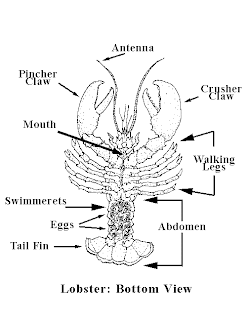I feel like I struck question gold on this (no urine pun intended). What's most awesome about the answer to this question is that it involves a whole slew of major organ systems in your body. On to the details!
When old blood cells retire the hemoglobin in them gets broken down into bilirubin. This is no small thing. You have 30 trillion red blood cells in your body and each of those cells has 270 million hemoglobin molecules in it. Just to be able to have a stable red blood cell count and compensate for loss you have to make 2.7 million red blood cells a second!! Bilirubin is also the yellow substance that causes bruises to appear yellow, as well as the yellow pallor of jaundice.
 |
| I thought this was interesting. It's all about moving oxygen and electrons! |
 |
| Notice how it basically just loses the iron and gets splayed out. |
This worn out hemoglobin gets disposed of in two places. One is our liver. The liver is a thrifty organ and filters bilirubin out of the blood, concentrating it in the gall bladder as one of the main constituents in bile ('Bile' and the first half of 'bilirubin' come from the same Latin root meaning 'anger', 'wrath', or 'gall'. 'Rubin' means red, so literally it means 'red wrath'.). Bile is squirted into our G.I. tract and does a great job emulsifying fats for us to process. You may know someone that has had a gall stone and suffered from the symptom of intense pain after eating fatty foods. Their body is trying to pump out bile to break down the fats, but is being painfully blocked. If a severe enough condition exists, gall bladder removal surgery may be prescribed, in which case the patient will have to eat a low fat diet (or deal in other ways) since high fat content without a means of processing the fats can cause serious indigestion and bloating. Assuming proper function, the bilirubin in bile gets further broken down by bacteria in the gut into a brown substance called urobiligen, which is the main reason our feces is brown.
The liver, however, doesn't catch all of the bilirubin floating through the blood stream and the excess gets mopped up by the kidneys to be disposed of. Before leaving the body it's further broken down into urobilin, which, you guessed it, is yellow. So, no, it's not urea that makes our urine yellow. Urea is colorless.
 |
| ***Be really careful with this photo. Those colors are for distinguishing them ONLY. Not true colors. |
Review:
Hemoglobin in blood breaks down into bilirubin which is filtered out by A) liver or B) kidney
A) Our liver concentrates it in the gallbladder as bile, which then pumps it into the intestines and is broken down by bacteria into the brown we know our feces as.
B) Our kidney further breaks bilirubin down into urobilin which is yellow and excreted in our urine.
From blood to Liver to Gallbladder to Intestines to Poo.
Blood to Kidneys to Wee.
Red (of blood) to Green (of bile) to Brown (of poo).
Red (of blood) to Yellow (of wee).
So, the next time you use the ole water closet, remember that your pee is yellow and your poo brown because it's broken down blood!!
Amazing ways evolution has made things look like bird sh*t:
Now, bird crap's a whole different story. When amino acids, the building blocks of proteins, break down (for a number of reasons, like they were digested but not used by the body or just as the wearing out of protein) they can turn into urea directly or its nastier cousin ammonia which is quickly broken down by the kidneys into the safer urea. Well, that's how it goes if you're a mammal, anyway. Birds and reptiles do things a little more complicated for two reasons. One is to save water. Urea is water soluble and therefore needs to be flushed out with large quantities of water in order to be disposed of. This means, as mammals, we're constantly throwing away a relatively large amount of perfectly good water in order to get rid of urea. Birds and reptiles solve this problem by expending a little more metabolic energy and turning broken down amino acids into uric acid which is relatively insoluble and can be concentrated as the white precipitate paste we see in bird poo (often mixed with brown since they poo/wee out of the same orifice and usually at the same time).
The other more interesting reason is to solve an egg problem. When a fetus in utero makes waste, the mommy is nice enough to dispose of the babies waste through the placenta. If you are a species that is isolated in eggs urine trouble! (Get it? Get it?...) They have to isolate their waste so it doesn't poison the entire egg. One of the most effective ways of doing this is to make it mostly insoluble in water so it can't spread - make it into uric acid. Genius.
It's interesting to note some exceptions. Some turtles start off making uric acid while in the egg to get its largely insoluble advantage, but then later in life switch to urea (like us) since it takes less metabolic energy to make (I assume the same is true for egg laying mammals like platypuses and echidnas which do use urea later in life). The kangaroo rat, even though it's a mammal, is another exception that has evolved to survive in a harsh desert environment by using the water conserving uric acid method of amino acid disposal.
I hope you never think of using the bathroom the same!
Works Sighted [sic]:
http://www.strangequestions.com/question/583/Why-is-urine-yellow.html#ixzz1C69R7NKk
http://www.thenakedscientists.com/HTML/content/latest-questions/question/2213/
http://www.whycenter.com/why-is-urine-yellow/
http://scienceblogs.com/startswithabang/2009/04/putting_the_yellow_in_your_uri.php
http://xenophilius.wordpress.com/2010/08/04/ask-a-scientist-why-is-urine-yellow-is-it-gold-urobilin/
http://www.expasy.ch/cgi-bin/show_image?L5&down
http://sxxz.blogspot.com/2006/07/why-is-urine-yellow.html
http://www.primermagazine.com/2009/field-manual/why-is-bird-poop-white
http://www.thenakedscientists.com/HTML/content/latest-questions/question/2213/
http://www.whycenter.com/why-is-urine-yellow/
http://scienceblogs.com/startswithabang/2009/04/putting_the_yellow_in_your_uri.php
http://xenophilius.wordpress.com/2010/08/04/ask-a-scientist-why-is-urine-yellow-is-it-gold-urobilin/
http://www.expasy.ch/cgi-bin/show_image?L5&down
http://sxxz.blogspot.com/2006/07/why-is-urine-yellow.html
http://www.primermagazine.com/2009/field-manual/why-is-bird-poop-white
Pictures from here, here, here, here, here, here, here, here, here, here, here, here, here, here, here, here, here and here.














































